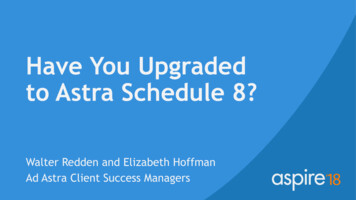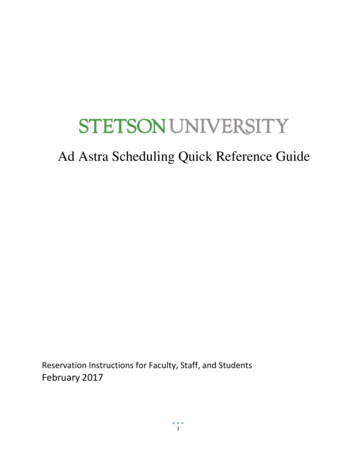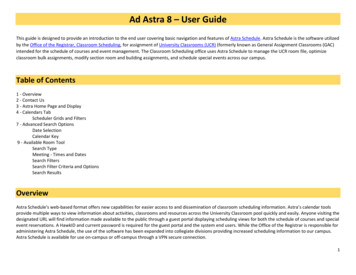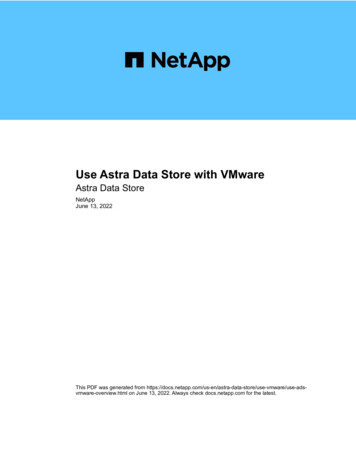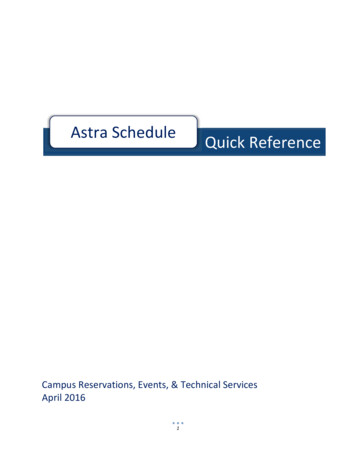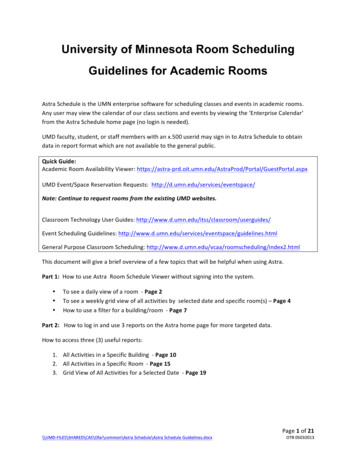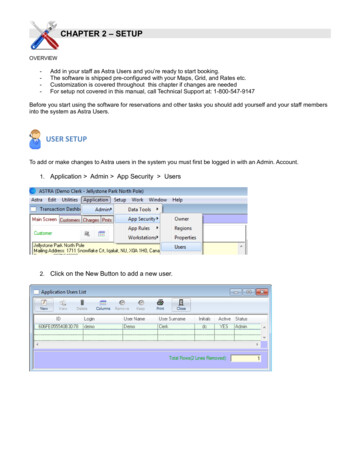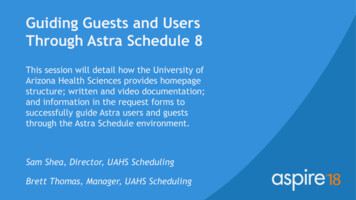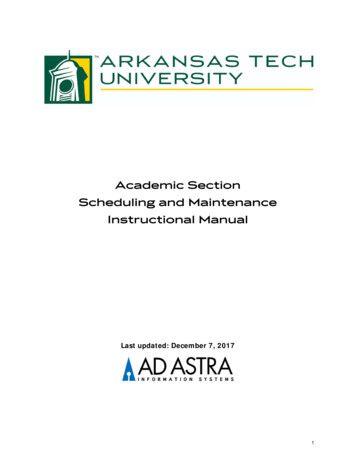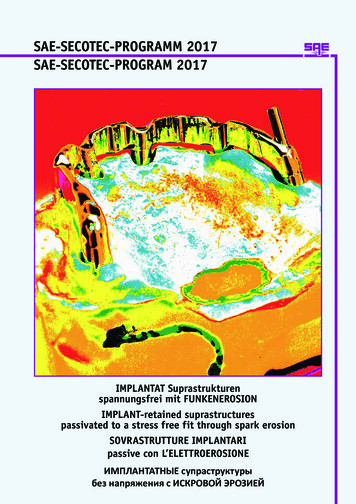
Transcription
Get startedAstra Control Center 22.04 documentationNetAppAugust 03, 2022This PDF was generated from -2204/getstarted/requirements.html on August 03, 2022. Always check docs.netapp.com for the latest.
Table of ContentsGet started . . . . . . . . . . . . . . . . . . . . . . . . . . . . . . . . . . . . . . . . . . . . . . . . . . . . . . . . . . . . . . . . . . . . . . . . . . . . . . 1Astra Control Center requirements . . . . . . . . . . . . . . . . . . . . . . . . . . . . . . . . . . . . . . . . . . . . . . . . . . . . . . . . . 1Quick start for Astra Control Center . . . . . . . . . . . . . . . . . . . . . . . . . . . . . . . . . . . . . . . . . . . . . . . . . . . . . . . . . 6Installation overview . . . . . . . . . . . . . . . . . . . . . . . . . . . . . . . . . . . . . . . . . . . . . . . . . . . . . . . . . . . . . . . . . . . . . 7Set up Astra Control Center . . . . . . . . . . . . . . . . . . . . . . . . . . . . . . . . . . . . . . . . . . . . . . . . . . . . . . . . . . . . . . 45Frequently asked questions for Astra Control Center . . . . . . . . . . . . . . . . . . . . . . . . . . . . . . . . . . . . . . . . . . 64
Get startedAstra Control Center requirementsGet started by verifying the readiness of your operational environment, application clusters, applications,licenses, and web browser.Operational environment requirementsAstra Control Center requires one of the following types of operational environments: Kubernetes 1.20 to 1.23 Rancher 2.5.8, 2.5.9, or 2.6 with RKE1 Red Hat OpenShift Container Platform 4.6.8, 4.7, 4.8, or 4.9 VMware Tanzu Kubernetes Grid 1.4 VMware Tanzu Kubernetes Grid Integrated Edition 1.12.2Ensure that the operating environment you choose to host Astra Control Center meets the basic resourcerequirements outlined in the environment’s official documentation. Astra Control Center requires the followingresources in addition to the environment’s resource requirements:ComponentRequirementStorage backend capacityAt least 500GB availableWorker nodesAt least 3 worker nodes total, with 4 CPU cores and12GB RAM eachFQDN addressAn FQDN address for Astra Control CenterAstra Trident Astra Trident 21.04 or newer installed andconfigured Astra Trident 21.10.1 or newer installed andconfigured if Astra Data Store will be used as astorage backendThese requirements assume that Astra Control Center is the only application running in theoperational environment. If the environment is running additional applications, adjust theseminimum requirements accordingly. Image registry: You must have an existing private Docker image registry to which you can push AstraControl Center build images. You need to provide the URL of the image registry where you will upload theimages. Astra Trident / ONTAP configuration: Astra Control Center requires that a storage class be created andset as the default storage class. Astra Control Center supports the following ONTAP drivers provided byAstra Trident: ontap-nas ontap-nas-flexgroup1
ontap-san ontap-san-economyDuring app cloning in OpenShift environments, Astra Control Center needs to allow OpenShift tomount volumes and change the ownership of files. Because of this, you need to configure anONTAP volume export policy to allow these operations. You can do so with the followingcommands:1. export-policy rule modify -vserver storage virtual machine name -policyname policy name -ruleindex 1 -superuser sys2. export-policy rule modify -vserver storage virtual machine name -policyname policy name -ruleindex 1 -anon 65534If you plan to add a second OpenShift operational environment as a managed computeresource, you need to ensure that the Astra Trident Volume Snapshot feature is enabled. Toenable and test volume snapshots with Astra Trident, see the official Astra Trident instructions.VMware Tanzu Kubernetes Grid cluster requirementsWhen hosting Astra Control Center on a VMware Tanzu Kubernetes Grid (TKG) or Tanzu Kubernetes GridIntegrated Edition (TKGi) cluster, keep in mind the following considerations. Disable the TKG or TKGi default storage class enforcement on any application clusters intended to bemanaged by Astra Control. You can do this by editing the TanzuKubernetesCluster resource on thenamespace cluster. You must create a security policy that allows Astra Control Center to create pods within the cluster. You cando this using the following commands:kubectl config use-context context-of-workload-cluster kubectl create clusterrolebinding default-tkg-admin-privileged-binding--clusterrole psp:vmware-system-privileged --group system:authenticated Be aware of specific requirements for Astra Trident when you deploy Astra Control Center in a TKG orTKGi environment. For more information, see the Astra Trident documentation.The default VMware TKG and TKGi configuration file token expires ten hours after deployment.If you use Tanzu portfolio products, you must generate a Tanzu Kubernetes Clusterconfiguration file with a non-expiring token to prevent connection issues between Astra ControlCenter and managed application clusters. For instructions, visit the VMware NSX-T Data CenterProduct Documentation.Supported storage backendsAstra Control Center supports the following storage backends. Astra Data Store NetApp ONTAP 9.5 or newer AFF and FAS systems NetApp Cloud Volumes ONTAP2
Application cluster requirementsAstra Control Center has the following requirements for clusters that you plan to manage from Astra ControlCenter. These requirements also apply if the cluster you plan to manage is the operational environment clusterthat hosts Astra Control Center. The most recent version of the Kubernetes snapshot-controller component is installed An Astra Trident volumesnapshotclass object has been defined by an administrator A default Kubernetes storage class exists on the cluster At least one storage class is configured to use Astra TridentYour application cluster should have a kubeconfig.yaml file that defines only one contextelement. Visit the Kubernetes documentation for information about creating kubeconfig files.When managing application clusters in a Rancher environment, modify the application cluster’sdefault context in the kubeconfig file provided by Rancher to use a control plane contextinstead of the Rancher API server context. This reduces load on the Rancher API server andimproves performance.Application management requirementsAstra Control has the following application management requirements: Licensing: To manage applications using Astra Control Center, you need an Astra Control Center license. Namespaces: Astra Control requires that an app not span more than a single namespace, but anamespace can contain more than one app. StorageClass: If you install an application with a StorageClass explicitly set and you need to clone theapp, the target cluster for the clone operation must have the originally specified StorageClass. Cloning anapplication with an explicitly set StorageClass to a cluster that does not have the same StorageClass willfail. Kubernetes resources: Applications that use Kubernetes resources not collected by Astra Control mightnot have full app data management capabilities. Astra Control collects the following Kubernetes lidatingWebhook3
Supported application installation methodsAstra Control supports the following application installation methods: Manifest file: Astra Control supports apps installed from a manifest file using kubectl. For example:kubectl apply -f myapp.yaml Helm 3: If you use Helm to install apps, Astra Control requires Helm version 3. Managing and cloning appsinstalled with Helm 3 (or upgraded from Helm 2 to Helm 3) is fully supported. Managing apps installed withHelm 2 is not supported. Operator-deployed apps: Astra Control supports apps installed with namespace-scoped operators. Thefollowing are some apps that have been validated for this installation model: Apache K8ssandra Jenkins CI Percona XtraDB ClusterAn operator and the app it installs must use the same namespace; you might need to modify thedeployment .yaml file for the operator to ensure this is the case.Access to the internetYou should determine whether you have outside access to the internet. If you do not, some functionality mightbe limited, such as receiving monitoring and metrics data from NetApp Cloud Insights, or sending supportbundles to the NetApp Support Site.LicenseAstra Control Center requires an Astra Control Center license for full functionality. Obtain an evaluation licenseor full license from NetApp. Without a license, you will be unable to: Define custom apps Create snapshots or clones of existing apps Configure data protection policiesIf you want to try Astra Control Center, you can use a 90-day evaluation license.To learn more about how licenses work, see Licensing.Ingress for on-premises Kubernetes clustersYou can choose the type of network ingress Astra Control Center uses. By default, Astra Control Centerdeploys the Astra Control Center gateway (service/traefik) as a cluster-wide resource. Astra Control Centeralso supports using a service load balancer, if they are permitted in your environment. If you would rather use aservice load balancer and you don’t already have one configured, you can use the MetalLB load balancer toautomatically assign an external IP address to the service. In the internal DNS server configuration, you shouldpoint the chosen DNS name for Astra Control Center to the load-balanced IP address.4
If you are hosting Astra Control Center on a Tanzu Kubernetes Grid cluster, use the kubectlget nsxlbmonitors -A command to see if you already have a service monitor configured toaccept ingress traffic. If one exists, you should not install MetalLB, because the existing servicemonitor will override any new load balancer configuration.Networking requirementsThe operational environment that hosts Astra Control Center communicates using the following TCP ports. Youshould ensure that these ports are allowed through any firewalls, and configure firewalls to allow any HTTPSegress traffic originating from the Astra network. Some ports require connectivity both ways between theenvironment hosting Astra Control Center and each managed cluster (noted where applicable).You can deploy Astra Control Center in a dual-stack Kubernetes cluster, and Astra ControlCenter can manage applications and storage backends that have been configured for dual-stackoperation. For more information about dual-stack cluster requirements, see the Kubernetesdocumentation.SourceDestinationClient PCMetrics consumerPortProtocolPurposeAstra Control Center 443HTTPSUI / API access Ensure this port isopen both waysbetween the clusterhosting Astra ControlCenter and eachmanaged clusterAstra Control Center 9090worker nodeHTTPSMetrics datacommunication ensure eachmanaged cluster canaccess this port onthe cluster hostingAstra Control Center(two-waycommunicationrequired)Astra Control Center Hosted Cloud443Insights d InsightscommunicationAstra Control Center Amazon S3 storage 443bucket m/)HTTPSAmazon S3 storagecommunicationAstra Control Center NetApp AutoSupport 443(https://support.netapp.com)HTTPSNetApp AutoSupportcommunication5
Supported web browsersAstra Control Center supports recent versions of Firefox, Safari, and Chrome with a minimum resolution of1280 x 720.What’s nextView the quick start overview.Quick start for Astra Control CenterThis page provides a high-level overview of the steps needed to get started with Astra Control Center. Thelinks within each step take you to a page that provides more details.Try it out! If you want to try Astra Control Center, you can use a 90-day evaluation license. See licensinginformation for details.Review Kubernetes cluster requirements Astra works with Kubernetes clusters with a Trident-configured ONTAP storage backend or an Astra DataStore storage backend. Clusters must be running in a healthy state, with at least three online worker nodes. The cluster must be running Kubernetes.Learn more about the Astra Control Center requirements.Download and install Astra Control Center Download Astra Control Center from the NetApp Support Site Astra Control Center Downloads page. Install Astra Control Center in your local environment.Optionally, install Astra Control Center using Red Hat OperatorHub.Learn more about installing Astra Control Center.Complete some initial setup tasks Add a license. Add a Kubernetes cluster and Astra Control Center discovers details. Add an ONTAP or Astra Data Store storage backend. Optionally, add an object store bucket that will store your app backups.Learn more about the initial setup process.Use Astra Control CenterAfter you finish setting up Astra Control Center, here’s what you might do next:6
Manage an app. Learn more about how to manage apps. Optionally, connect to NetApp Cloud Insights to display metrics on the health of your system, capacity, andthroughput inside the Astra Control Center UI. Learn more about connecting to Cloud Insights.Continue from this Quick StartInstall Astra Control Center.Find more information Use the Astra Control APIInstallation overviewChoose and complete one of the following Astra Control Center installation procedures: Install Astra Control Center using the standard process (If you use Red Hat OpenShift) Install Astra Control Center using OpenShift OperatorHub Install Astra Control Center with a Cloud Volumes ONTAP storage backendInstall Astra Control Center using the standard processTo install Astra Control Center, download the installation bundle from the NetApp Support Site and perform thefollowing steps to install Astra Control Center Operator and Astra Control Center in your environment. You canuse this procedure to install Astra Control Center in internet-connected or air-gapped environments.For Red Hat OpenShift environments, you can also use an alternative procedure to install Astra Control Centerusing OpenShift OperatorHub.What you’ll need Before you begin installation, prepare your environment for Astra Control Center deployment. Ensure all cluster operators are in a healthy state and available.OpenShift example:oc get clusteroperators Ensure all API services are in a healthy state and available:OpenShift example:oc get apiservices The Astra FQDN you plan to use needs to be routable to this cluster. This means that you either have aDNS entry in your internal DNS server or you are using a core URL route that is already registered.About this task7
The Astra Control Center installation process does the following: Installs the Astra components into the netapp-acc (or custom-named) namespace. Creates a default account. Establishes a default administrative user email address and default one-time password of ACC UUID of installation for this instance of Astra Control Center. This user is assigned the Ownerrole in the system and is needed for first time login to the UI. Helps you determine that all Astra Control Center pods are running. Installs the Astra UI.(Applies to the Astra Data Store Early Access Program (EAP) release only) If you intend tomanage Astra Data Store using Astra Control Center and enable VMware workflows, deployAstra Control Center only on the pcloud namespace and not on the netapp-acc namespaceor a custom namespace described in the steps of this procedure.Do not execute the following command during the entirety of the installation process to avoiddeleting all Astra Control Center pods: kubectl delete -fastra control center operator deploy.yamlIf you are using Red Hat’s Podman instead of Docker Engine, Podman commands can be usedin place of Docker commands.StepsTo install Astra Control Center, do the following steps: Download and unpack the Astra Control Center bundle Install the NetApp Astra kubectl plugin Add the images to your local registry Set up namespace and secret for registries with auth requirements Install the Astra Control Center operator Configure Astra Control Center Complete Astra Control Center and operator installation Verify system status Set up ingress for load balancing Log in to the Astra Control Center UIDownload and unpack the Astra Control Center bundle1. Download the Astra Control Center bundle (astra-control-center-[version].tar.gz) from theNetApp Support Site.2. Download the zip of Astra Control Center certificates and keys from the NetApp Support Site.3. (Optional) Use the following command to verify the signature of the bundle:8
openssl dgst -sha256 -verify astra-control-center[version].pub-signature astra-control-center[version].sig astra-controlcenter[version].tar.gz4. Extract the images:tar -vxzf astra-control-center-[version].tar.gzInstall the NetApp Astra kubectl pluginThe NetApp Astra kubectl command line plugin saves time when performing common tasks associated withdeploying and upgrading Astra Control Center.What you’ll needNetApp provides binaries for the plugin for different CPU architectures and operating systems. You need toknow which CPU and operating system you have before you perform this task. On Linux and Mac operatingsystems, you can use the uname -a command to gather this information.Steps1. List the available NetApp Astra kubectl plugin binaries, and note the name of the file you need for youroperating system and CPU architecture:ls kubectl-astra/2. Copy the file to the same location as the standard kubectl utility. In this example, the kubectl utility islocated in the /usr/local/bin directory. Replace binary-name with the name of the file you need:cp kubectl-astra/ binary-name /usr/local/bin/kubectl-astraAdd the images to your local registry1. Change to the Astra directory:cd acc2. Add the files in the Astra Control Center image directory to your local registry.See sample scripts for the automatic loading of images below.a. Log in to your registry:Docker:9
docker login [your registry path]Podman:podman login [your registry path]b. Use the appropriate script to load the images, tag the images, andregistry:push the images to your localDocker:export REGISTRY [Docker registry path]for astraImageFile in (ls images/*.tar) ; do# Load to local cache. And store the name of the loaded imagetrimming the 'Loaded images: 'astraImage (docker load --input {astraImageFile} sed 's/Loadedimage: //')astraImage (echo {astraImage} sed 's!localhost/!!')# Tag with local image repo.docker tag {astraImage} {REGISTRY}/ {astraImage}# Push to the local repo.docker push {REGISTRY}/ {astraImage}donePodman:export REGISTRY [Registry path]for astraImageFile in (ls images/*.tar) ; do# Load to local cache. And store the name of the loaded imagetrimming the 'Loaded images: 'astraImage (podman load --input {astraImageFile} sed 's/Loadedimage(s): //')astraImage (echo {astraImage} sed 's!localhost/!!')# Tag with local image repo.podman tag {astraImage} {REGISTRY}/ {astraImage}# Push to the local repo.podman push {REGISTRY}/ {astraImage}doneSet up namespace and secret for registries with auth requirements1. If you use a registry that requires authentication, you need to do the following:10
a. Create the netapp-acc-operator namespace:kubectl create ns perator createdb. Create a secret for the netapp-acc-operator namespace. Add Docker information and run thefollowing command:kubectl create secret docker-registry astra-registry-cred -n netappacc-operator --docker-server [your registry path] --docker-username [username] --docker-password [token]Sample response:secret/astra-registry-cred createdc. Create the netapp-acc (or custom named) namespace.kubectl create ns [netapp-acc or custom namespace]Sample response:namespace/netapp-acc createdd. Create a secret for the netapp-acc (or custom named) namespace. Add Docker information and runthe following command:kubectl create secret docker-registry astra-registry-cred -n [netappacc or custom namespace] --docker-server [your registry path]--docker-username [username] --docker-password [token]Responsesecret/astra-registry-cred createde.(Optional) If you want the cluster to be automatically managed by Astra Control Center after11
installation, make sure that you provide the kubeconfig as a secret within the Astra Control Centernamespace you intend to deploy into using this command:kubectl create secret generic [acc-kubeconfig-cred or custom secretname] --from-file path-to-your-kubeconfig -n [netapp-acc or customnamespace]Install the Astra Control Center operator1. Edit the Astra Control Center operator deployment YAML(astra control center operator deploy.yaml) to refer to your local registry and secret.vim astra control center operator deploy.yamla. If you use a registry that requires authentication, replace the default line of imagePullSecrets: []with the following:imagePullSecrets:- name: name of secret with creds to local registry b. Change [your registry path] for the kube-rbac-proxy image to the registry path where youpushed the images in a previous step.c. Change [your registry path] for the acc-operator-controller-manager image to theregistry path where you pushed the images in a previous step.d. (For installations using Astra Data Store preview) See this known issue regarding storage classprovisioners and additional changes you will need to make to the YAML.12
apiVersion: apps/v1kind: Deploymentmetadata:labels:control-plane: controller-managername: acc-operator-controller-managernamespace: netapp-acc-operatorspec:replicas: 1selector:matchLabels:control-plane: -plane: controller-managerspec:containers:- args:- --secure-listen-address 0.0.0.0:8443- --upstream http://127.0.0.1:8080/- --logtostderr true- --v 10image: [your registry path]/kube-rbac-proxy:v4.8.0name: kube-rbac-proxyports:- containerPort: 8443name: https- args:- --health-probe-bind-address :8081- --metrics-bind-address 127.0.0.1:8080- --leader-electcommand:- /managerenv:- name: ACCOP LOG LEVELvalue: "2"image: [your registry path]/acc-operator:[version x.y.z]imagePullPolicy: IfNotPresentimagePullSecrets: []2. Install the Astra Control Center operator:kubectl apply -f astra control center operator deploy.yaml13
Sample response:namespace/netapp-acc-operator io/astracontrolcenters.astra.netapp.io -leader-election-role perator-manager-role orization.k8s.io/acc-operator-proxy-role perator-leader-electionrolebinding o/acc-operator-managerrolebinding o/acc-operator-proxyrolebinding createdconfigmap/acc-operator-manager-config rics-service ager createdConfigure Astra Control Center1. Edit the Astra Control Center custom resource (CR) file (astra control center min.yaml) to makeaccount, autoSupport, registry, and other necessary configurations:If additional customizations are required for your environment, you can useastra control center.yaml as an alternative CR.astra control center min.yaml is the default CR and is suitable for mostinstallations.vim astra control center min.yamlProperties configured by the CR cannot be changed after initial Astra Control Centerdeployment.If you are using a registry that does not require authorization, you must delete the secretline within imageRegistry or the installation will fail.a. Change [your registry path] to the registry path where you pushed the images in the previousstep.b. Change the accountName string to the name you want to associate with the account.c. Change the astraAddress string to the FQDN you want to use in your browser to access Astra. Donot use http:// or https:// in the address. Copy this FQDN for use in a later step.14
d. Change the email string to the default initial administrator address. Copy this email address for use ina later step.e. Change enrolled for AutoSupport to false for sites without internet connectivity or retain true forconnected sites.f. (Optional) Add a first name firstName and last name lastName of the user associated with theaccount. You can perform this step now or later within the UI.g. (Optional) Change the storageClass value to another Trident storageClass resource if required byyour installation.h. (Optional) If you want the cluster to be automatically managed by Astra Control Center after installationand you have already created the secret containing the kubeconfig for this cluster, provide the name ofthe secret by adding a new field to this YAML file called astraKubeConfigSecret: "acckubeconfig-cred or custom secret name"i. Complete one of the following steps: Other ingress controller (ingressType:Generic): This is the default action with Astra ControlCenter. After Astra Control Center is deployed, you will need to configure the ingress controller toexpose Astra Control Center with a URL.The default Astra Control Center installation sets up its gateway (service/traefik) to be of thetype ClusterIP. This default installation requires you to additionally set up a KubernetesIngressController/Ingress to route traffic to it. If you want to use an ingress, see Set up ingress forload balancing. Service load balancer (ingressType:AccTraefik): If you don’t want to install an IngressControlleror create an Ingress resource, set ingressType to AccTraefik.This deploys the Astra Control Center traefik gateway as a Kubernetes LoadBalancer typeservice.Astra Control Center uses a service of the type "LoadBalancer" (svc/traefik in the Astra ControlCenter namespace), and requires that it be assigned an accessible external IP address. If loadbalancers are permitted in your environment and you don’t already have one configured, you canuse MetalLB or another external service load balancer to assign an external IP address to theservice. In the internal DNS server configuration, you should point the chosen DNS name for AstraControl Center to the load-balanced IP address.For details about the service type of "LoadBalancer" and ingress, see Requirements.15
apiVersion: astra.netapp.io/v1kind: AstraControlCentermetadata:name: astraspec:accountName: "Example"astraVersion: "ASTRA VERSION"astraAddress: "astra.example.com"astraKubeConfigSecret: "acc-kubeconfig-cred or custom secret name"ingressType: "Generic"autoSupport:enrolled: trueemail: "[admin@example.com]"firstName: "SRE"lastName: "Admin"imageRegistry:name: "[your registry path]"secret: "astra-registry-cred"storageClass: "ontap-gold"Complete Astra Control Center and operator installation1. If you didn’t already do so in a previous step, create the netapp-acc (or custom) namespace:kubectl create ns [netapp-acc or custom namespace]Sample response:namespace/netapp-acc created2. Install Astra Control Center in the netapp-acc (or your custom) namespace:kubectl apply -f astra control center min.yaml -n [netapp-acc or customnamespace]Sample response:astracontrolcenter.astra.netapp.io/astra created16
Verify system statusIf you prefer to use OpenShift, you can use comparable oc commands for verification steps.1. Verify that all system components installed successfully.kubectl get pods -n [netapp-acc or custom namespace]Each pod should have a status of Running. It may take several minutes before the system pods aredeployed.Sample nning01/1Running01/1Running017
1Running01/1Running0
0mpolaris-mongodb-210mpolaris-ui-84dc87847f-zrg8w
Here is an overview of the process to install Astra Control Center for AWS with Cloud Volumes ONTAP as a storage backend. Each of these steps is explained in more detail below. 1. Ensure that you have sufficient IAM permissions. 2. Install a RedHat OpenShift cluster on AWS. 3. Configure AWS. 4. Configure NetApp Cloud Manager. 5. Install Astra .
